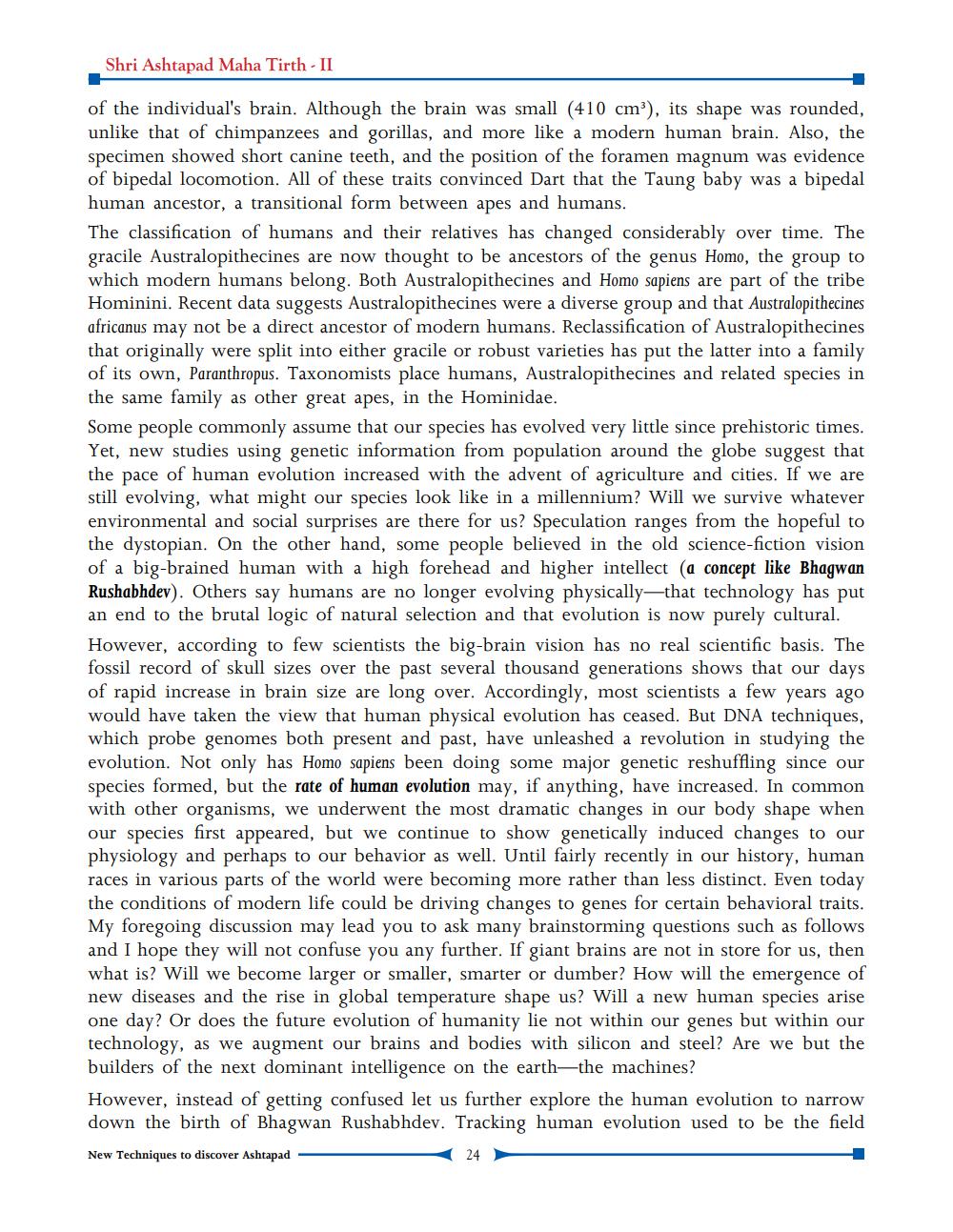________________
Shri Ashtapad Maha Tirth - II
of the individual's brain. Although the brain was small (410 cm), its shape was rounded, unlike that of chimpanzees and gorillas, and more like a modern human brain. Also, the specimen showed short canine teeth, and the position of the foramen magnum was evidence of bipedal locomotion. All of these traits convinced Dart that the Taung baby was a bipedal human ancestor, a transitional form between apes and humans. The classification of humans and their relatives has changed considerably over time. The gracile Australopithecines are now thought to be ancestors of the genus Homo, the group to which modern humans belong. Both Australopithecines and Homo sapiens are part of the tribe Hominini. Recent data suggests Australopithecines were a diverse group and that Australopithecines africanus may not be a direct ancestor of modern humans. Reclassification of Australopithecines that originally were split into either gracile or robust varieties has put the latter into a family of its own, Paranthropus. Taxonomists place humans, Australopithecines and related species in the same family as other great apes, in the Hominidae. Some people commonly assume that our species has evolved very little since prehistoric times. Yet, new studies using genetic information from population around the globe suggest that the pace of human evolution increased with the advent of agriculture and cities. If we are still evolving, what might our species look like in a millennium? Will we survive whatever environmental and social surprises are there for us? Speculation ranges from the hopeful to the dystopian. On the other hand, some people believed in the old science-fiction vision of a big-brained human with a high forehead and higher intellect (a concept like Bhagwan Rushabhdev). Others say humans are no longer evolving physically—that technology has put an end to the brutal logic of natural selection and that evolution is now purely cultural. However, according to few scientists the big-brain vision has no real scientific basis. The fossil record of skull sizes over the past several thousand generations shows that our days of rapid increase in brain size are long over. Accordingly, most scientists a few years ago would have taken the view that human physical evolution has ceased. But DNA techniques, which probe genomes both present and past, have unleashed a revolution in studying the evolution. Not only has Homo sapiens been doing some major genetic reshuffling since our species formed, but the rate of human evolution may, if anything, have increased. In common with other organisms, we underwent the most dramatic changes in our body shape when our species first appeared, but we continue to show genetically induced changes to our physiology and perhaps to our behavior as well. Until fairly recently in our history, human races in various parts of the world were becoming more rather than less distinct. Even today the conditions of modern life could be driving changes to genes for certain behavioral traits. My foregoing discussion may lead you to ask many brainstorming questions such as follows and I hope they will not confuse you any further. If giant brains are not in store for us, then what is? Will we become larger or smaller, smarter or dumber? How will the emergence of new diseases and the rise in global temperature shape us? Will a new human species arise one day? Or does the future evolution of humanity lie not within our genes but within our technology, as we augment our brains and bodies with silicon and steel? Are we but the builders of the next dominant intelligence on the earth—the machines? However, instead of getting confused let us further explore the human evolution to narrow down the birth of Bhagwan Rushabhdev. Tracking human evolution used to be the field
New Techniques to discover Ashtapad




